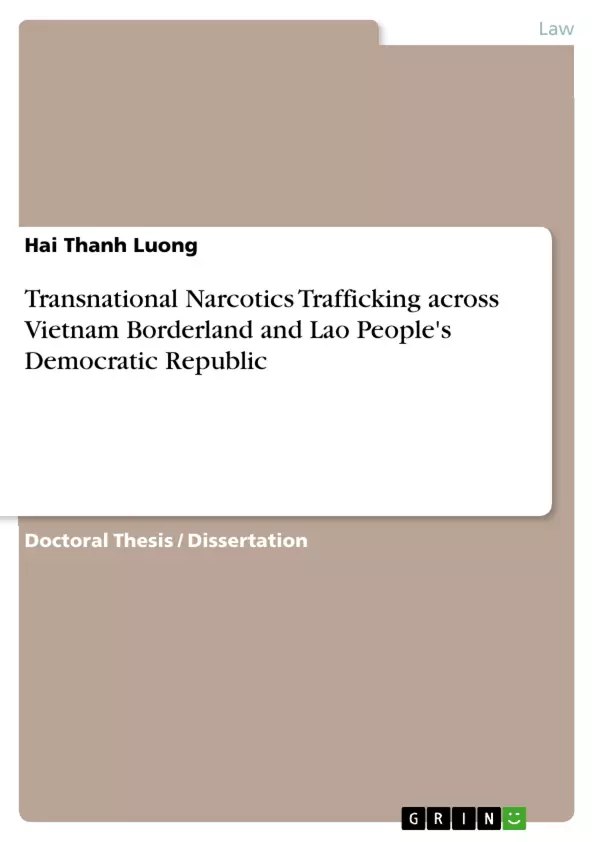Close proximity to the major production zones, porous borderlands, mountainous frontiers and long coastlines offer advantageous conditions for trafficking narcotics. The illicit drug situation has become much more complex in Vietnam with the growth in amphetamine-type stimulants production and trade. Even so, empirical research and analysis of the organization and operation of transnational narcotics trafficking (TransNT) remains limited. The purpose of this thesis is to present the first detailed inquiry into the nature of TransNT across the border between Lao People’s Democratic Republic (PDR) and Vietnam using an exploratory approach which draws upon qualitative and quantitative methods. In particular, the thesis presents findings from case studies of cross-border trafficking between Vietnam and Lao PDR in the period of 2003-2013 combined with interview and survey data from criminal investigation police and drug-related crimes officers (CIPDRC) from six border provinces who are directly and indirectly involved in investigating these cases.
The findings of this study indicate that drug markets in Vietnam are not controlled by monopolistic, hierarchical organizations or ‘cartels’. The structures of TransNT entities operating across the Lao-Vietnam border are small, based on family ties and fellow-countrymen relations, are fluid and loosely organized. They are very adaptable and sophisticated with diverse modus operandi and multiple divisions of labour. This presents particular challenges to law enforcement agencies (LAEs).
This thesis questions to capacity of Vietnam’s police to enforce the government’s zero-tolerance anti-narcotics policy. The study highlights practical problems and specific barriers in combating TransNT. LEAs in Vietnam and Lao PDR operate without effective mechanisms to cooperate and share information. It is also the case that traffickers often have more sophisticated equipment at their disposal to help them avoid arrest. Police forces work within national structures and yet are faced with the task of combatting transnational crime. This reality affects law enforcement capacity at a national as well as regional level, but Association of the Southeast Asian Nations member states have yet to establish effective structures for dealing with this non-traditional security challenge. Based on these findings, therefore, the thesis proposes recommendations to enhancing the effectiveness of LEAs to combat TransNT between Vietnam and Lao PDR.
Inhaltsverzeichnis (Table of Contents)
- Chapter 1: Introduction
- 1.1. Background and statement
- 1.2. Research purpose and question
- 1.3. Scope and definition
- 1.4. Synopsis of the thesis
- Chapter 2: Literature review
- 2.1. Chapter overview and objective
- 2.2. Cross-border concerns and their impact on transnational narcotics trafficking
- 2.3. Applying social network analysis to drug trafficking studies
- 2.4. Criminal networks and their implications to drug trafficking
- 2.5. Modus operandi in drug trafficking script's stages
- 2.6. Typologies of transnational narcotics trafficking
- 2.7. Summary of chapter
- Chapter 3: Research Method
- 3.1. Chapter overview and objectives
- 3.2. Researching transnational narcotics trafficking
- 3.3. Mixed methods research (MMR)
- 3.4. Mixed method exploratory sequential design
- 3.5. Some constraints and solutions
- 3.6. Summary of chapter
- Chapter 4: Key findings
- 4.1. Chapter overview and objectives
- 4.2. Descriptive case studies
- 4.3. Structural components in transnational narcotics trafficking entities
- 4.4. Crime script analysis
- 4.5. Summary of chapter
- Chapter 5: Law enforcement officers assessments of transnational narcotics trafficking
- 5.1. Chapter overview and objectives
- 5.2. Survey implementation
- 5.3. Survey findings
- 5.4. Barriers and challenges to combat transnational narcotics trafficking
- 5.5. Summary of chapter
- Chapter 6: Interpretation and discussion
- 6.1. Chapter overview and objectives
- 6.2. The nature of transnational narcotics trafficking: compare and contrast
- 6.3. Initial recommendations and prioritized issues for enhancing cooperation to combat transnational narcotics trafficking
- 6.4. Summary of chapter
Zielsetzung und Themenschwerpunkte (Objectives and Key Themes)
This research explores the intricacies of transnational narcotics trafficking in Vietnam, aiming to understand its structural characteristics and the impact of transnational criminal networks. The study seeks to offer insights into the methods and strategies employed by these networks, ultimately aiming to inform and improve law enforcement efforts against this illicit trade.
- The impact of transnational criminal networks on narcotics trafficking in Vietnam
- The organizational structure and methods of transnational narcotics trafficking entities
- The role of social network analysis in understanding drug trafficking dynamics
- Challenges faced by law enforcement in combating transnational narcotics trafficking
- Recommendations for enhancing cooperation and combating transnational narcotics trafficking
Zusammenfassung der Kapitel (Chapter Summaries)
The first chapter sets the stage for the research by providing a detailed background on narcotics trafficking in Vietnam and the broader context of transnational crime. It lays out the research question and objectives, along with the scope and methodology to be employed. Chapter two delves into a comprehensive literature review exploring relevant scholarly work on transnational narcotics trafficking, cross-border criminal activities, and the application of social network analysis in drug trafficking studies. The chapter examines existing typologies and modus operandi in transnational drug trafficking. Chapter three focuses on the research methodology, detailing the mixed methods approach employed, including both quantitative and qualitative data collection methods. This chapter explains the rationale for using a mixed methods design and outlines the specific procedures and tools used in the study.
Schlüsselwörter (Keywords)
The research centers around the keywords: transnational narcotics trafficking, Vietnam, criminal networks, social network analysis, law enforcement, cross-border crime, mixed methods research, drug trafficking, modus operandi, typologies, challenges, recommendations, cooperation.
- Arbeit zitieren
- Dr. Hai Thanh Luong (Autor:in), 2017, Transnational Narcotics Trafficking across Vietnam Borderland and Lao People's Democratic Republic, München, GRIN Verlag, https://www.grin.com/document/366349



